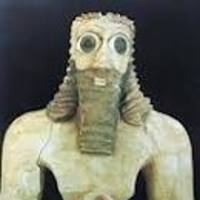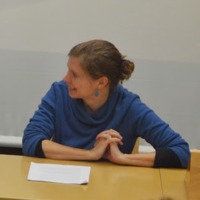Projects by Natalie Naomi May

Why colophons?
The scribal system was the primary vehicle for transmitting and preserving knowled... more Why colophons?
The scribal system was the primary vehicle for transmitting and preserving knowledge in Mesopotamia in the first millennium BCE. Writing and copying literary and scientific compositions was part of education in scribal schools. Ideally, the entire career of a scribe, from his apprenticeship to becoming an “experienced scribe, who neglects nothing,” can be traced thanks to the colophons that he appended at the bottom of his works throughout his lifetime. Although they called themselves “scribes”, they were in fact scholars and scientists, the keepers of scribal lore, legal tradition and historical records. Many were affiliated to temples and royal courts, but others practised privately.
Their colophons contain a wealth of information on the transfer of knowledge. Firstly, by giving us the name of the scribe, his master, and the tablet’s owner, they shed light on the genealogies (whether real or imagined) of scholars and on the networks of patronage in which they worked. Secondly, by giving the date and place of a tablet’s production, they enable us to trace the transmission of knowledge through space and time. Ca. 2100 colophons we know of come from all major Assyrian and Babylonian libraries, royal, institutional and private, that range in time from the beginning of the Assyrian domination of Mesopotamia (9th century BCE) until the collapse of the Empire in the late 7th century. The potential for ground-breaking research into the social contexts of one of mankind’s longest-living traditions of learning is beyond doubt, but until now, this wealth of information has remained untapped. My project is intended to change this situation. By analysing the colophon data I expect to come to a better understanding of the social and cultural process of transmitting knowledge in the ancient Near East. I shall compile a complete digital database of all known Assyrian and Babylonian colophons to establish an infrastructure for future research.

Ancient Near Eastern societies provide us with numerous examples of the highest religious authori... more Ancient Near Eastern societies provide us with numerous examples of the highest religious authority being held by the ruler. The divine entity of kingship, which descended from heaven, according to the Sumerian King List and the Etana myth, was ingrained in Mesopotamian consciousness from earliest times. Assyrian kings were high priests of Aššur, the state tutelary deity. The king as mediator between his subjects and the divine realm was responsible for the well-being of the land and the correct conduct of religious ceremonies.
Although there is no evidence of formal deification of the Neo-Assyrian kings, their “special relationship” with the gods and sacral character of their power must be taken into consideration. The differences and similarities with the phenomenon of deification of the ruler in the Akkadian and Ur III periods, as well as diachronic analysis of king-gods relations in other periods of Mesopotamian history provide us with clearer understanding of the divine aspects of Assyrian kingship and specific forms of adoration of royalty in the Neo-Assyrian Empire, which constitute the Assyrian “theology of royalty.” This “theology of royalty” substituted the direct deification of a mortal ruler by introducing the cognition of the king’s superhuman nature into the consciousness of his subjects using metaphoric allusions, both textual and visual.
The main objective of the project Metaphors of Divinity is to explore the place and role of the king in religious cults and ceremonies of the Neo-Assyrian period through the parallel exploration of visual and written sources. I will further investigate the impact of the Assyrian concept of kingship on the formation of state and royal ideology of Judah as reflected in the Hebrew Bible.
Books by Natalie Naomi May
Israel Antiquities Authority Reports 10, 2000
Edited Books by Natalie Naomi May
Proceedings of the 59th Rencontre Assyriologique Internationale Workshop with Other Papers Included, State Archives of Assyria Bulletin 21, special issue
State Archives of Assyria Bulletin 21, special issue, 2015
Oriental Institute Seminars 8. Chicago: Oriental Institute, 2012
Culture and History of the Ancient Near East, 68, Brill, 2014
Since Max Weber who denied that the Oriental cities were "real" cities , effforts of many scholar... more Since Max Weber who denied that the Oriental cities were "real" cities , effforts of many scholars have been aimed at establishing a connection between the city form and its socio-political structure.1 It has often been claimed that the city plan mirrors a city's political organisation.2 The lack of preconceived public spaces in the Near Eastern cities as opposite to the city-states of the Classical Antiquity was one of the focuses of these discussions (Liverani 1997, 91-93; May / Steinert, Introduction, this volume).
Book Chapters by Natalie Naomi May
The Synagogue of Korazim. The 1962–1964, 1980–1987. Jerusalem, Israel Antiquities Authority (with Z. Yeivin and D.T. Ariel; in Hebrew). Israel Antiquities Authority Reports 10, 2000
The Synagogue of Korazim. The 1962–1964, 1980–1987. Jerusalem, Israel Antiquities Authority (with Z. Yeivin and D.T. Ariel; in Hebrew)., 2000
The Synagogue of Korazim. The 1962–1964, 1980–1987. Jerusalem, Israel Antiquities Authority (with Z. Yeivin and D.T. Ariel; in Hebrew)., 2000
Papers by Natalie Naomi May
Writing and Re-Writing History by Destruction , 2022
NABU, 2019
Early Monumental Representations of Constellations in Mari: the Moon between the Giant and the Bu... more Early Monumental Representations of Constellations in Mari: the Moon between the Giant and the Bull of Heaven-Representation of constellations is a topic largely neglected in Assyriology and history of ancient Near Eastern art mostly because of the abuse made of this subject by panbabylonists, 1) The article "On The Origins of 'Aquarius'" by Edith Porada, which she contributed to the Festschrift Reiner, remains almost the only art-historian work on depictions of constellations (PORADA 1987). 2) As is evident from the recent NABU note on the mural in salle 132 of the Mari palace (fig. 1) by Astrid Nunn (NUNN 2019), this paper of the greatest authority on Mesopotamian seals escaped the attention of her colleagues. I am indebted to Nunn whose note gave me a push to write this communication.

Kasion 8 The King as a Nodal Point of Neo-Assyrian Identity , 2022
Scholars of the ancient Near East divided by their languages of expertise often forget that it wa... more Scholars of the ancient Near East divided by their languages of expertise often forget that it was one world, which did not yet have a single "imperial" language. Peoples of this world interacted actively through wars and trade, as well as through alliances and treaties. Small states looked up on their overlords and imitated their fancy habits and the overlords often borrowed skills from their subjects. But foreign habits were followed not only for their fanciness but also for their efficiency. The Assyrian Empire and Assyrian kingship created an administrative, ideological and political system, which remained a model for copying long after the fall of Assyria. Assyrian administrative apparatus, was employed by the Neo-Babylonian court and administration as Michael Jursa has demonstrated. 2 The Persian Empire copy-pasted the Assyrian one in almost everything, from the programmatic palatial imagery and pictorial motives, military system, system of royal roads and royal post, provincial structure with the use of Aramaic as its administrative language and Assyrian system of receiving taxes and tribute on the New Year occasion to the places and ways of executing rebels. 3 Present paper deals with the imitations of the Assyrian king and Empire not by its mighty successors in the South and the East, but by its humble vassals in the West. The imagery proves that the imitations started instantly with the beginning of the Assyrian expansion under Assurnasirpal II in the NA period. 4 The stele of Kulamuwa, the 9 th century king of Sam'al, which he calls Y'dy, is inscribed with the Phoenician inscription. It bears the image of this overwise unknown ruler. The representation upon this stela reproduces not only the headgear of the Assyrian kings but their entire outfit in every small detail (fig. 1). The very gesture of the local ruler is the typically Assyrian adoration gesture, ubāna tarāṣu, stretching of a finger toward the symbols of the gods. These symbols are depicted in the upper part of his stele in exactly the same manner as they are depicted on Assyrian

Fs Parpola, 2023
Rehashing de Vogüé, all of us, who are dealing with first millennium Assyria, come out from the m... more Rehashing de Vogüé, all of us, who are dealing with first millennium Assyria, come out from the mantle of Simo Parpola's State Archives of Assyria Project. Studying the Neo-Assyrian period would be impossible without the SAA publications. Directly or indirectly, Simo is the mentor for all researchers of the NA period that are younger than he. His own generation would not be that successful without his fundamental work too. It is my pleasure and honour to dedicate to him this article on NA eunuch-scholars, especially since he has tremendously advanced the study of these two categories of NA personnelscholars and eunuchs-though each of them separately. Eunuchs, especially, the Assyrian ones, are particularly well studied. 1 According to the consensus, in the NA milieu ša/šūt rēši (lú SAG) means eunuch. 2 Some time ago Luis Siddall and Reinhard Pirngruber tried to prove that the term or its variants cannot be always taken as meaning "eunuch," but their argument does not hold water in the light of the direct evidence of the incantation, quoted already by Kirk Grayson: 3 GIM šu-ut re-e-ši la a-li-di ni-il-ka li-bal, "May your semen dry up like that of a eunuch who cannot beget." 4 In the bulk of research dedicated to Assyrian eunuchs, hardly anything has been written about eunuch-scholars. 5 Scholars in Mesopotamia were usually as

Aula Orientalis 41, 2023
לגנדי קורטיק, יהי זכרו ברוך
Gennady Kurtik in memoriam
The article investigates Mesopota... more לגנדי קורטיק, יהי זכרו ברוך
Gennady Kurtik in memoriam
The article investigates Mesopotamian figurations of constellations nowadays known as zodiacal from their earliest occurrence through the Hellenistic period in diachronic perspective. Special attention is paid to the revolutionary changes of the Middle Babylonian period, the archaeological evidence for it, the representation of constellations on kudurru and uninscribed calendrical tablet VAT 15377. The difference in depiction of the same constellations in Assyria and Babylonia is treated as well. A number of innovative interpretations of texts and imagery related to the representation of constellations is suggested, including the new interpretation of the inscription on cylinder seal from the former Erlenmeyer collection 1-the only inscribed seal from the Uruk period with the earliest known astronomical record. A new interpretation for the Babylonian man in the moon drawn on VAT 7851 is suggested based on the collated drawing and collation of SAA 3 39.] Keywords: risings and settings of Venus, figurations of constellations, zodiac, kudurru, calenders, man in the moon.
Gs Litvinsky, 2023
The article explores the subject so-far barely touched in research: representation of male nudity... more The article explores the subject so-far barely touched in research: representation of male nudity in Mesopotamia in its relation to status. Representations of male nakedness are explored in diachronic perspective from the earliest images of the Uruk period through the Late Babylonian ones. Textual sources at our disposal are used if relevant and helpful in understanding the imagery. I demonstrate how the attitude to nudity in Mesopotamia changes and evolves from the "natural" nudity in the fourth millennium BCE to the perception of nakedness as destitution in the first millennium BCE.

Tales of Royalty, 2020
Regarding one of the central questions that the workshop has raised: "What is narrative?" Ifollow... more Regarding one of the central questions that the workshop has raised: "What is narrative?" Ifollow the definitions suggested by Erich Dinckler and Herbert L. Kessler about the imagery of biblical stories.² Their view was close to that of Gérard Genette concerning narration, who pointed out that at riggerc ontained in a short phrase "the king died" implies the entire story that followed the king's death. Dinckler and Kessler distinguish between "abbreviatedr epresentations … reduced to the most essential figures, yetm aintaining the recognizability of the scene",³ and narrative representations. Thus, abbreviated( or monoscenic) depictions, which did not represent the story in its temporald evelopment weretechnicallynot narrations but rather META-narrations.⁴ Abbreviated scenes allude to an arration by representing as ingle but well-known scene, which relates to written or oral narration or is apart of awider pictorial narrative repertoire. In the sameway,certain verbal notions are not narrative,assuch, but can createanallusion to averbal narration. This is very much applicable to the Neo-Assyrian art because the spectator,e veni fi lliterate, knew the story behindt he depiction. Similarly, abbreviatedr epresentation of biblical scenes brought to mind for illiterate spectators biblical narrativesw ell known to wider audiences. The messageofthe story was transmittedtothe literate audience, as well, by use of certain expressions designating royal images. These expressions wereused as condensed abbreviations of the entire royal propaganda. The notion of an abbreviated representation standing for narration as awhole is equallyvalid for Assyrian pictorial and written sources. Royal stelae and expressions designating them in texts functioned as atriggerthatevoked the stories of Assyrian royal propaganda. The depictions on royal steles (ṣalam šarri/šarrūtija)a ss uch weren ot ap ictorial narrative.B ut they stood for narratives incisedupon them -that of amilitary campaign or building undertaking.The abbreviated representations, the king'seffigies hewn on stelae, symbolized royal victory or accomplishment of ab uilding project.They alluded to anarration about acampaign and avictory and werethemselvesdescribed by written and depicted in pictorial narrations. Stelae are not narrative images but these images are inseparable from the narrative textsi ncised upon them. The imageo nastela conveyedt oaspectator the narration written upon it.T hey, like statues, "are holisticallyu sed to conveyt he message."⁵ Royal effigyo ra p- Dinckler 1979,K essler 1979. Dinckler 1979,3 96;s ee also Wagner-Durand and Linke,t his volume ("Bound by Stories?!"), esp. 7. See Wagner-Durand and Linke, this volume ("WhyS tudy 'Narration'?"), 294. Wagner-Durand and Linke, this volume ("WhyStudy 'Narration'?"), 296,with the referenceto Cory Crowford. Even if economic or administrative. Cf. Wagner-Durand and Linke, this volume ("WhyS tudy 'Narration'?"), 306. See the Excursus: Brief HistoryofResearch and Interpretation of the Evidence at the end of the article. May2 008, part I, chapter2 . May2 008, part I, chapter2 . " The True Imageo ft he God…" This part deals onlywith the obvious cases of deification of the royal image. The example of the creation of an effigy (not necessarilyastatue) of the king, whose appearance and function areu nknown( Holloway2 002, 184-5) weren ot treated here. AHw1 078b -1079as .v. ṣalmum II 2. CAD Ṣ s.v. ṣalmu a, 78. CAD Ṣ s.v. ṣalmu 2′a′ , 80 -81. CAD Ṣ s.v. ṣalmu 2′b′, 81. CAD Ṣ s.v. ṣalmu 2′c′, 81-82.
RAI 64, 2023
The paper treats the concepts of an ideal city from their emergence in Mesopotamia and Syria thro... more The paper treats the concepts of an ideal city from their emergence in Mesopotamia and Syria through late antiquity. I will scrutinize the notion of the ideal city, analysing and comparing both written and archaeological sources. The use of mathematics in urban planning as well as its esoteric applications, such as numerology, as a part of the ideal city concept, will be discussed. Possible channels for transcultural conveyance of architectural ideas and skills will be suggested.











Uploads
Projects by Natalie Naomi May
The scribal system was the primary vehicle for transmitting and preserving knowledge in Mesopotamia in the first millennium BCE. Writing and copying literary and scientific compositions was part of education in scribal schools. Ideally, the entire career of a scribe, from his apprenticeship to becoming an “experienced scribe, who neglects nothing,” can be traced thanks to the colophons that he appended at the bottom of his works throughout his lifetime. Although they called themselves “scribes”, they were in fact scholars and scientists, the keepers of scribal lore, legal tradition and historical records. Many were affiliated to temples and royal courts, but others practised privately.
Their colophons contain a wealth of information on the transfer of knowledge. Firstly, by giving us the name of the scribe, his master, and the tablet’s owner, they shed light on the genealogies (whether real or imagined) of scholars and on the networks of patronage in which they worked. Secondly, by giving the date and place of a tablet’s production, they enable us to trace the transmission of knowledge through space and time. Ca. 2100 colophons we know of come from all major Assyrian and Babylonian libraries, royal, institutional and private, that range in time from the beginning of the Assyrian domination of Mesopotamia (9th century BCE) until the collapse of the Empire in the late 7th century. The potential for ground-breaking research into the social contexts of one of mankind’s longest-living traditions of learning is beyond doubt, but until now, this wealth of information has remained untapped. My project is intended to change this situation. By analysing the colophon data I expect to come to a better understanding of the social and cultural process of transmitting knowledge in the ancient Near East. I shall compile a complete digital database of all known Assyrian and Babylonian colophons to establish an infrastructure for future research.
Although there is no evidence of formal deification of the Neo-Assyrian kings, their “special relationship” with the gods and sacral character of their power must be taken into consideration. The differences and similarities with the phenomenon of deification of the ruler in the Akkadian and Ur III periods, as well as diachronic analysis of king-gods relations in other periods of Mesopotamian history provide us with clearer understanding of the divine aspects of Assyrian kingship and specific forms of adoration of royalty in the Neo-Assyrian Empire, which constitute the Assyrian “theology of royalty.” This “theology of royalty” substituted the direct deification of a mortal ruler by introducing the cognition of the king’s superhuman nature into the consciousness of his subjects using metaphoric allusions, both textual and visual.
The main objective of the project Metaphors of Divinity is to explore the place and role of the king in religious cults and ceremonies of the Neo-Assyrian period through the parallel exploration of visual and written sources. I will further investigate the impact of the Assyrian concept of kingship on the formation of state and royal ideology of Judah as reflected in the Hebrew Bible.
Books by Natalie Naomi May
Edited Books by Natalie Naomi May
Book Chapters by Natalie Naomi May
Papers by Natalie Naomi May
Gennady Kurtik in memoriam
The article investigates Mesopotamian figurations of constellations nowadays known as zodiacal from their earliest occurrence through the Hellenistic period in diachronic perspective. Special attention is paid to the revolutionary changes of the Middle Babylonian period, the archaeological evidence for it, the representation of constellations on kudurru and uninscribed calendrical tablet VAT 15377. The difference in depiction of the same constellations in Assyria and Babylonia is treated as well. A number of innovative interpretations of texts and imagery related to the representation of constellations is suggested, including the new interpretation of the inscription on cylinder seal from the former Erlenmeyer collection 1-the only inscribed seal from the Uruk period with the earliest known astronomical record. A new interpretation for the Babylonian man in the moon drawn on VAT 7851 is suggested based on the collated drawing and collation of SAA 3 39.] Keywords: risings and settings of Venus, figurations of constellations, zodiac, kudurru, calenders, man in the moon.
The scribal system was the primary vehicle for transmitting and preserving knowledge in Mesopotamia in the first millennium BCE. Writing and copying literary and scientific compositions was part of education in scribal schools. Ideally, the entire career of a scribe, from his apprenticeship to becoming an “experienced scribe, who neglects nothing,” can be traced thanks to the colophons that he appended at the bottom of his works throughout his lifetime. Although they called themselves “scribes”, they were in fact scholars and scientists, the keepers of scribal lore, legal tradition and historical records. Many were affiliated to temples and royal courts, but others practised privately.
Their colophons contain a wealth of information on the transfer of knowledge. Firstly, by giving us the name of the scribe, his master, and the tablet’s owner, they shed light on the genealogies (whether real or imagined) of scholars and on the networks of patronage in which they worked. Secondly, by giving the date and place of a tablet’s production, they enable us to trace the transmission of knowledge through space and time. Ca. 2100 colophons we know of come from all major Assyrian and Babylonian libraries, royal, institutional and private, that range in time from the beginning of the Assyrian domination of Mesopotamia (9th century BCE) until the collapse of the Empire in the late 7th century. The potential for ground-breaking research into the social contexts of one of mankind’s longest-living traditions of learning is beyond doubt, but until now, this wealth of information has remained untapped. My project is intended to change this situation. By analysing the colophon data I expect to come to a better understanding of the social and cultural process of transmitting knowledge in the ancient Near East. I shall compile a complete digital database of all known Assyrian and Babylonian colophons to establish an infrastructure for future research.
Although there is no evidence of formal deification of the Neo-Assyrian kings, their “special relationship” with the gods and sacral character of their power must be taken into consideration. The differences and similarities with the phenomenon of deification of the ruler in the Akkadian and Ur III periods, as well as diachronic analysis of king-gods relations in other periods of Mesopotamian history provide us with clearer understanding of the divine aspects of Assyrian kingship and specific forms of adoration of royalty in the Neo-Assyrian Empire, which constitute the Assyrian “theology of royalty.” This “theology of royalty” substituted the direct deification of a mortal ruler by introducing the cognition of the king’s superhuman nature into the consciousness of his subjects using metaphoric allusions, both textual and visual.
The main objective of the project Metaphors of Divinity is to explore the place and role of the king in religious cults and ceremonies of the Neo-Assyrian period through the parallel exploration of visual and written sources. I will further investigate the impact of the Assyrian concept of kingship on the formation of state and royal ideology of Judah as reflected in the Hebrew Bible.
Gennady Kurtik in memoriam
The article investigates Mesopotamian figurations of constellations nowadays known as zodiacal from their earliest occurrence through the Hellenistic period in diachronic perspective. Special attention is paid to the revolutionary changes of the Middle Babylonian period, the archaeological evidence for it, the representation of constellations on kudurru and uninscribed calendrical tablet VAT 15377. The difference in depiction of the same constellations in Assyria and Babylonia is treated as well. A number of innovative interpretations of texts and imagery related to the representation of constellations is suggested, including the new interpretation of the inscription on cylinder seal from the former Erlenmeyer collection 1-the only inscribed seal from the Uruk period with the earliest known astronomical record. A new interpretation for the Babylonian man in the moon drawn on VAT 7851 is suggested based on the collated drawing and collation of SAA 3 39.] Keywords: risings and settings of Venus, figurations of constellations, zodiac, kudurru, calenders, man in the moon.
hanging from the tree in the “Garden Scene” of Ashurbanipal as the head of his enemy, the Elamite king Te’umman. I prove that
this head belongs to another and much more hated enemy of the Assyrian king, the traitor Nabû-bēl-šumāti, whose dead body
Ashurbanipal ordered to decapitate.